Abstract
1. The role played by the 5-HT3 receptor, a serotonin subtype receptor, in peristaltic reflexes was studied in dogs first given ketamine, then anaesthetized with urethane (1.0 g kg-1, I.V.) and alpha-chloralose (100 mg kg-1, I.V.). The jejunal loop was partitioned into two segments with respect to blood supply. Drugs were infused intra-arterially into each segment. 2. Stroking of the mucosa of the aboral and oral segments elicited an ascending contraction and a descending relaxation, respectively. 3. The ascending contraction was concentration-dependently inhibited by treatment of the aboral segment with the 5-HT3 receptor antagonists ICS 205-930 and ondansetron (1.4 pmol min-1 to 14 nmol min-1 for both). The maximal inhibition was 49.5 and 69.3%, respectively. The response was not affected by treatment of the oral segment with these drugs. The descending relaxation was inhibited by 51.4 and 60.8%, respectively, by treatment of the oral segment with ICS 205-930 and ondansetron (1.4 nmol min-1 for both). 4. The ascending contraction was markedly inhibited by treatment of either segment with hexamethonium (140 nmol min-1). The response was abolished by treating both segments with hexamethonium and by treating the oral segment with atropine (14 nmol min-1). 5. These results suggest firstly that, in the canine jejunum, enteric neurons with 5-HT3 receptors play a role as sensory neurons or interneurons in the ascending excitatory and the descending inhibitory pathways of the peristaltic reflex elicited by stroking the mucosa, and secondly, that the ascending limb is composed of cholinergic interneurons and motoneurons.
Full text
PDF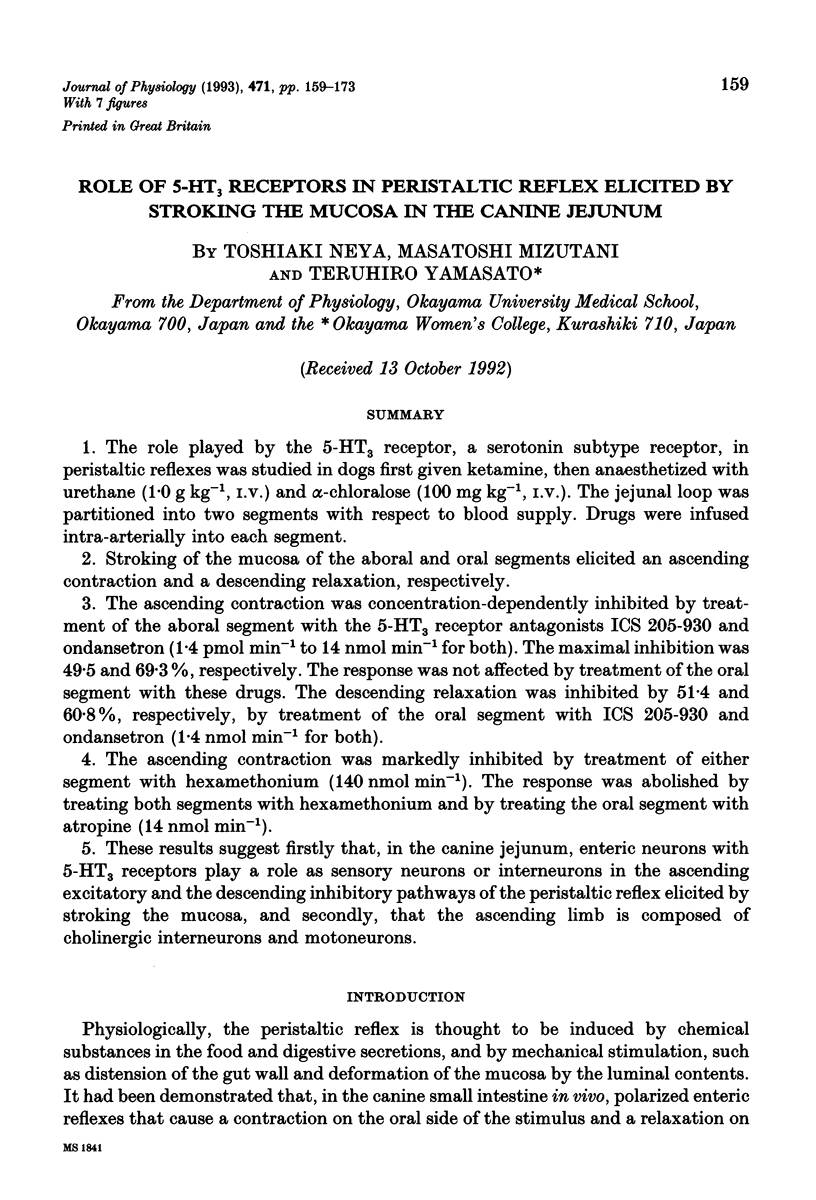
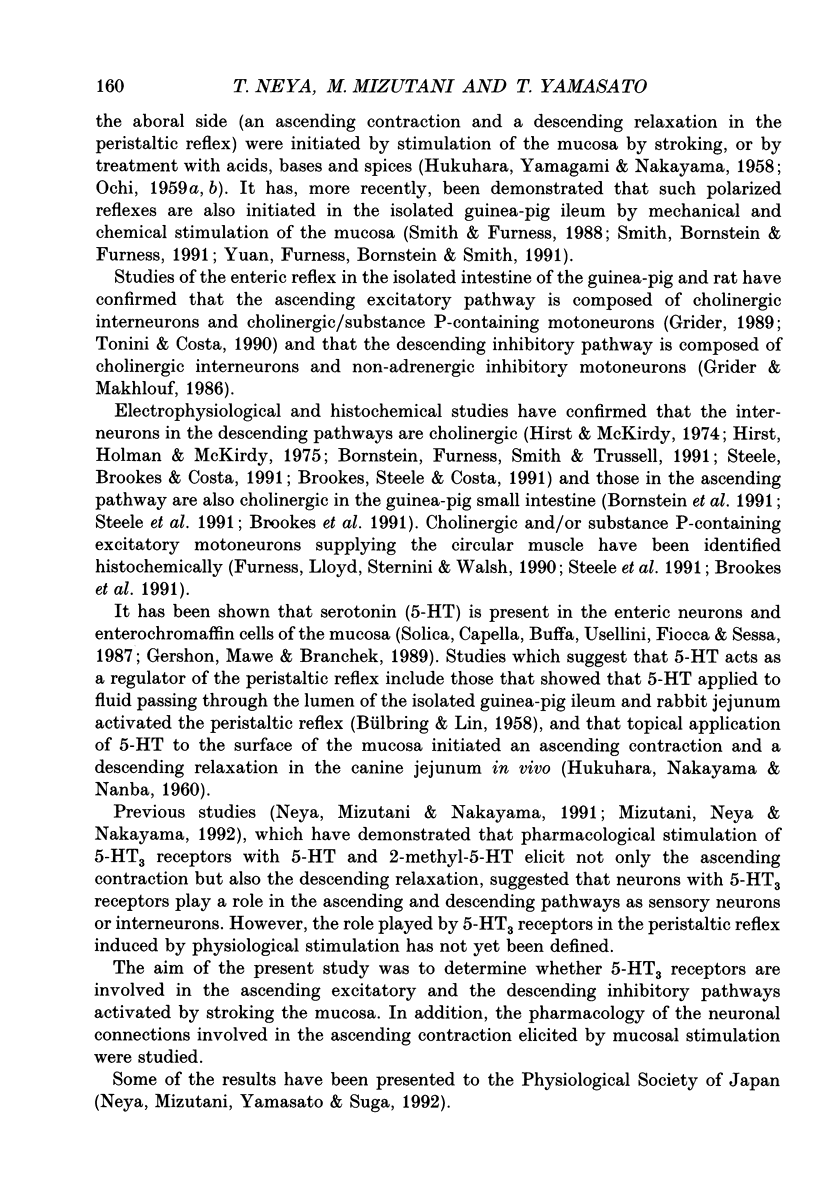
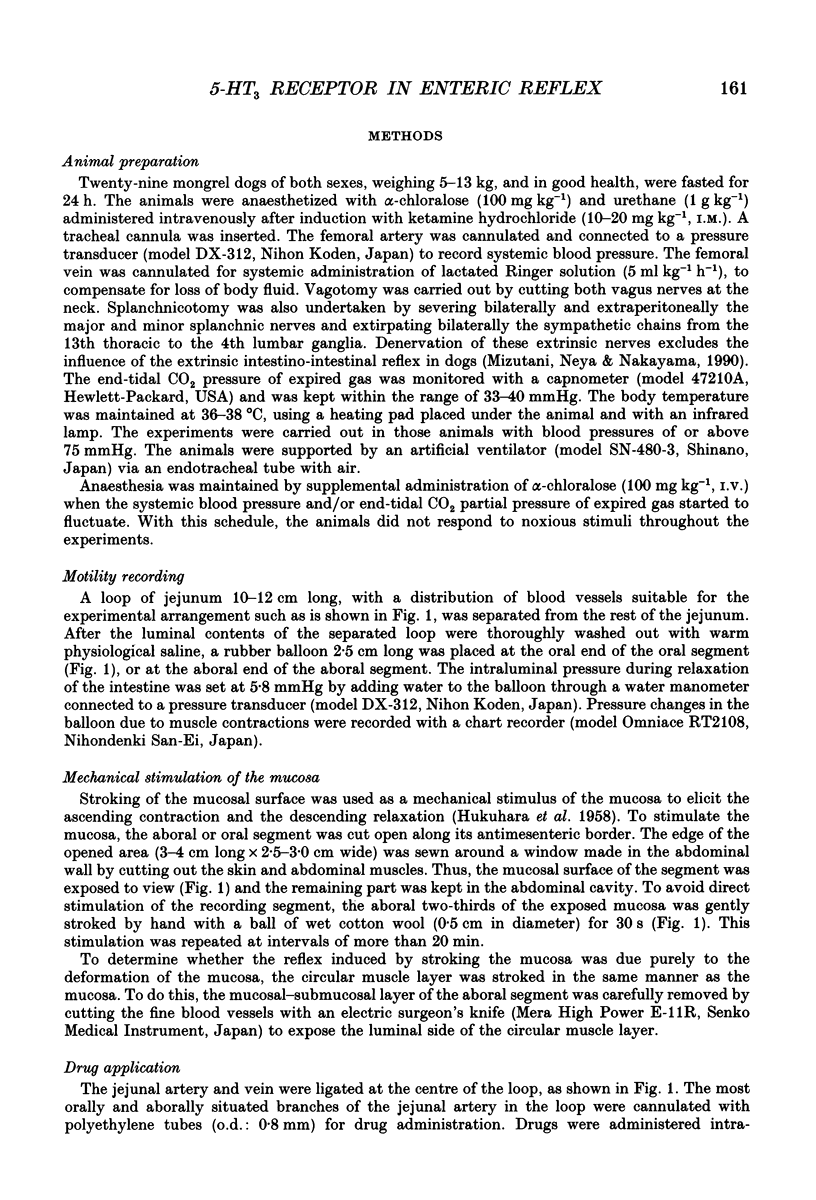
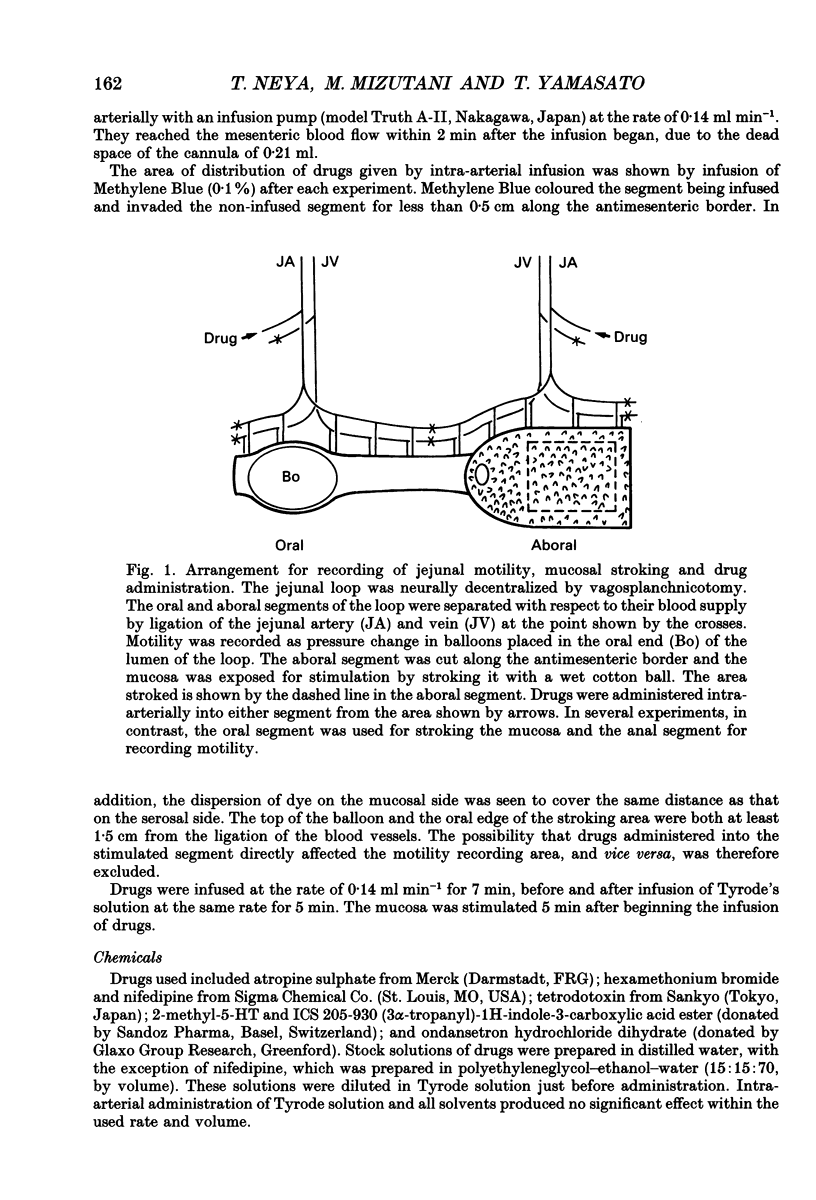
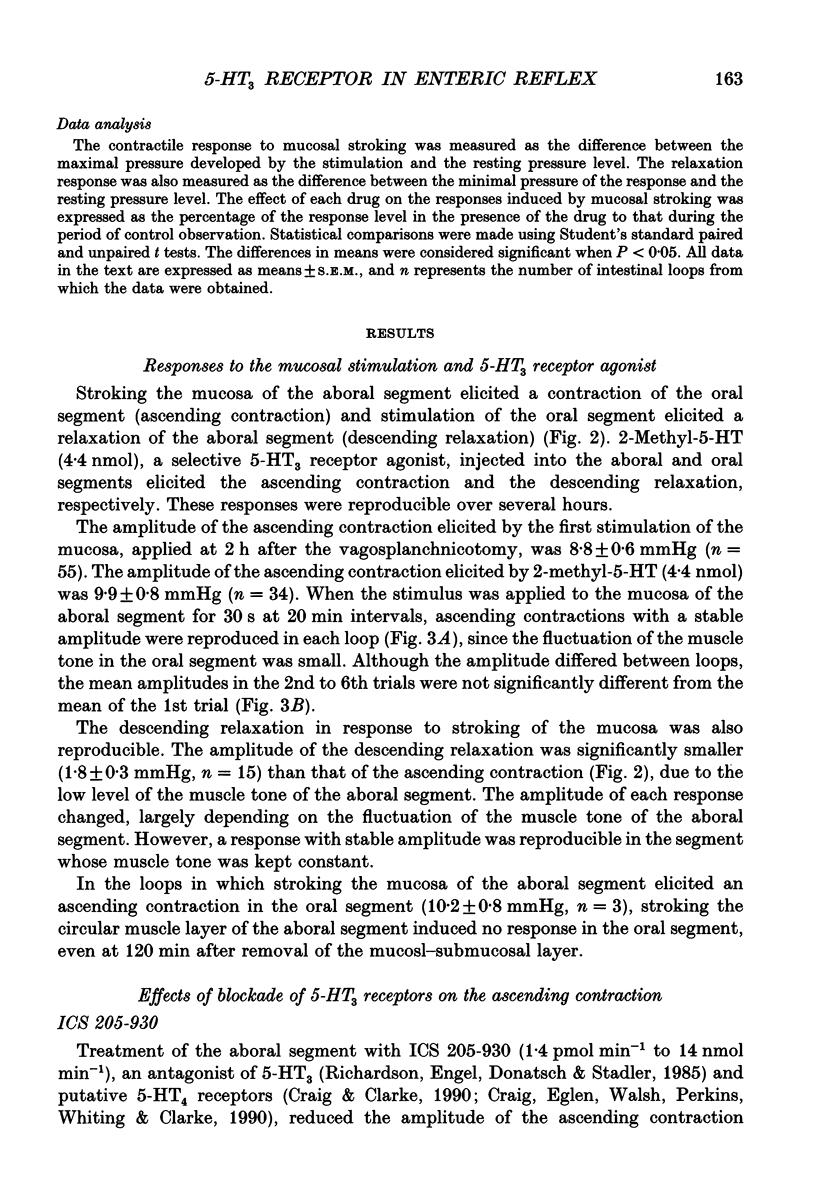
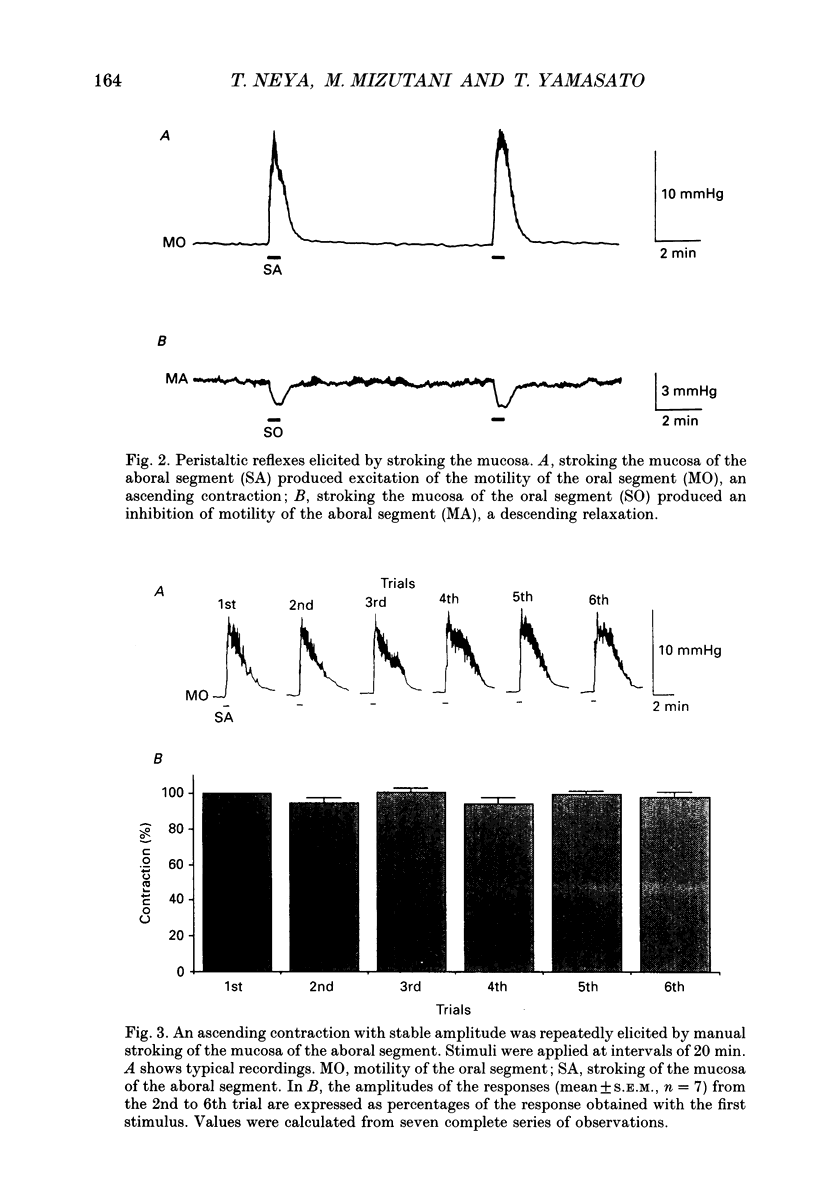
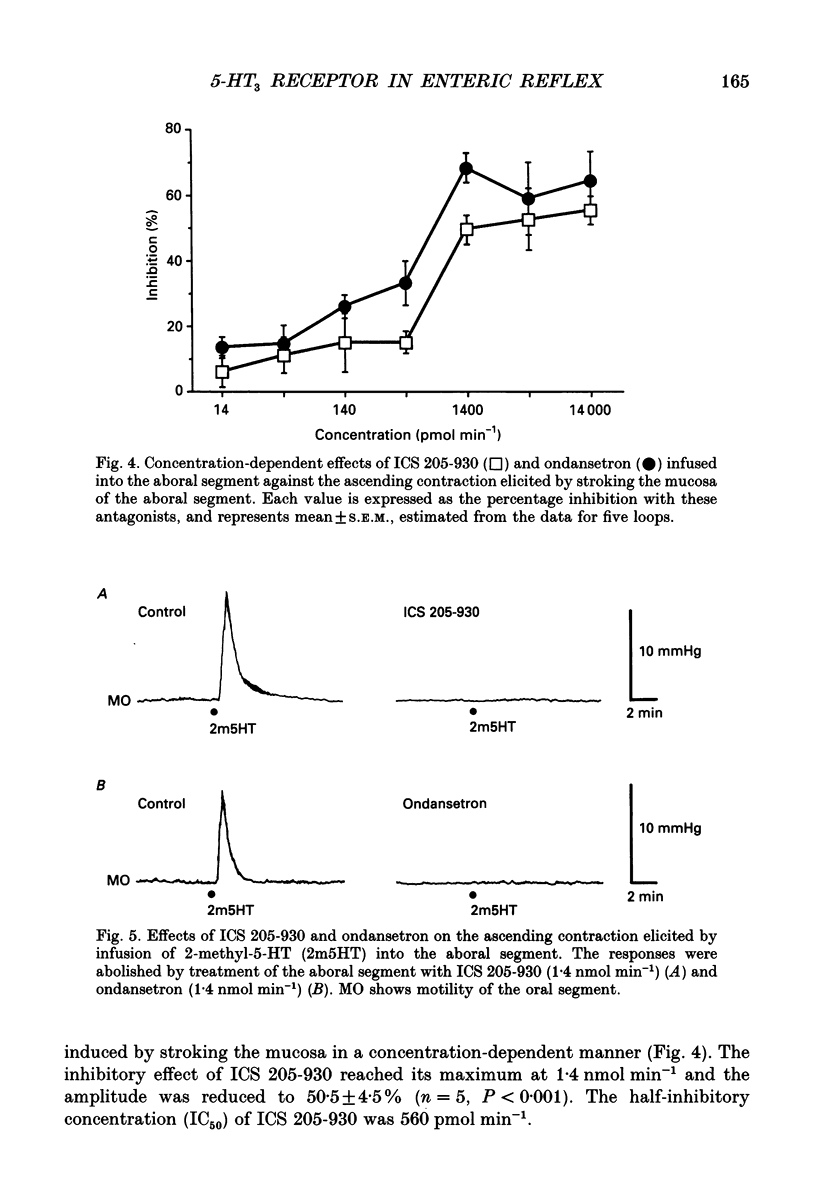
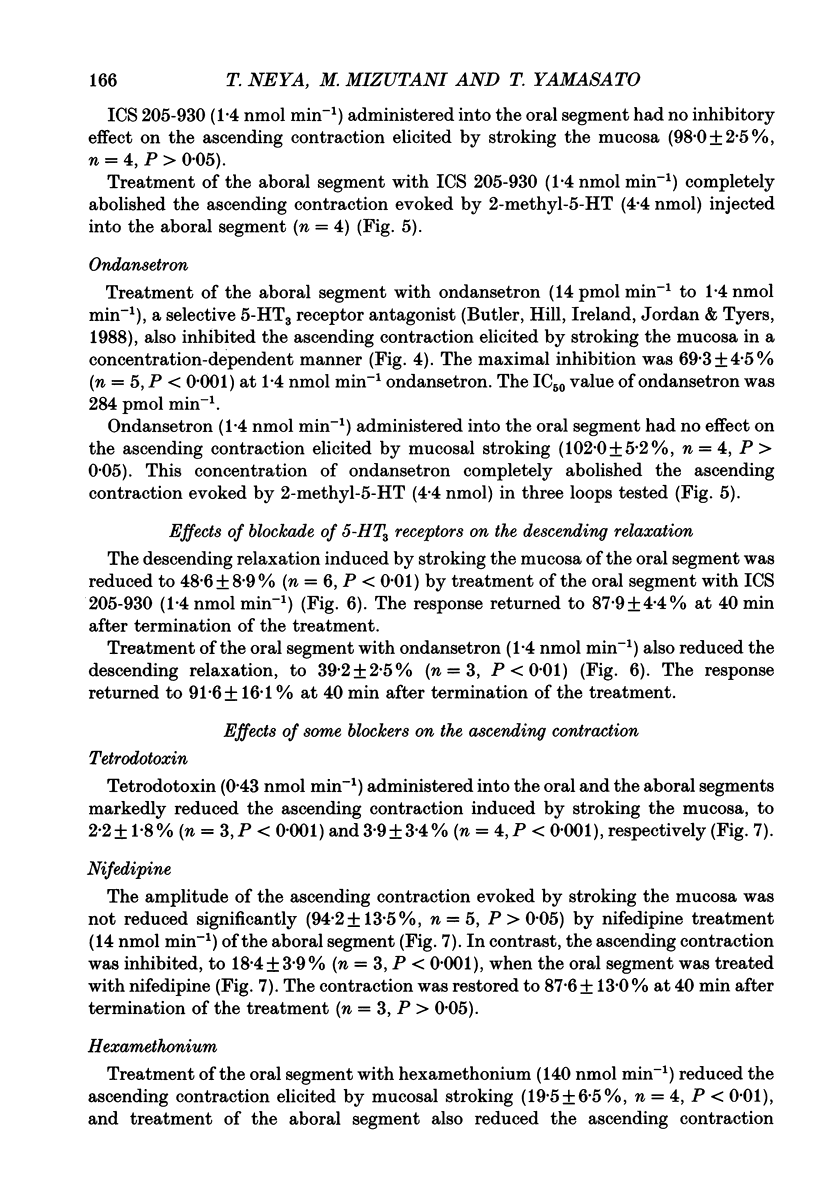
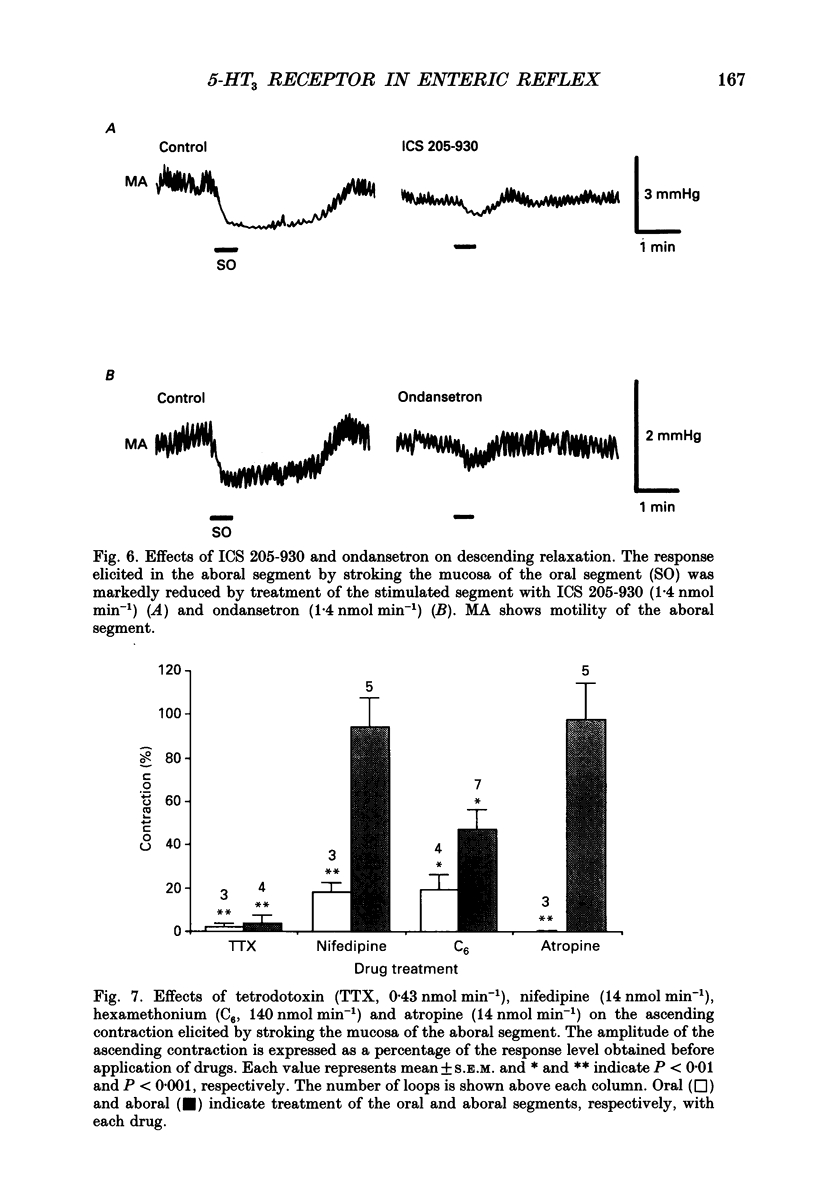
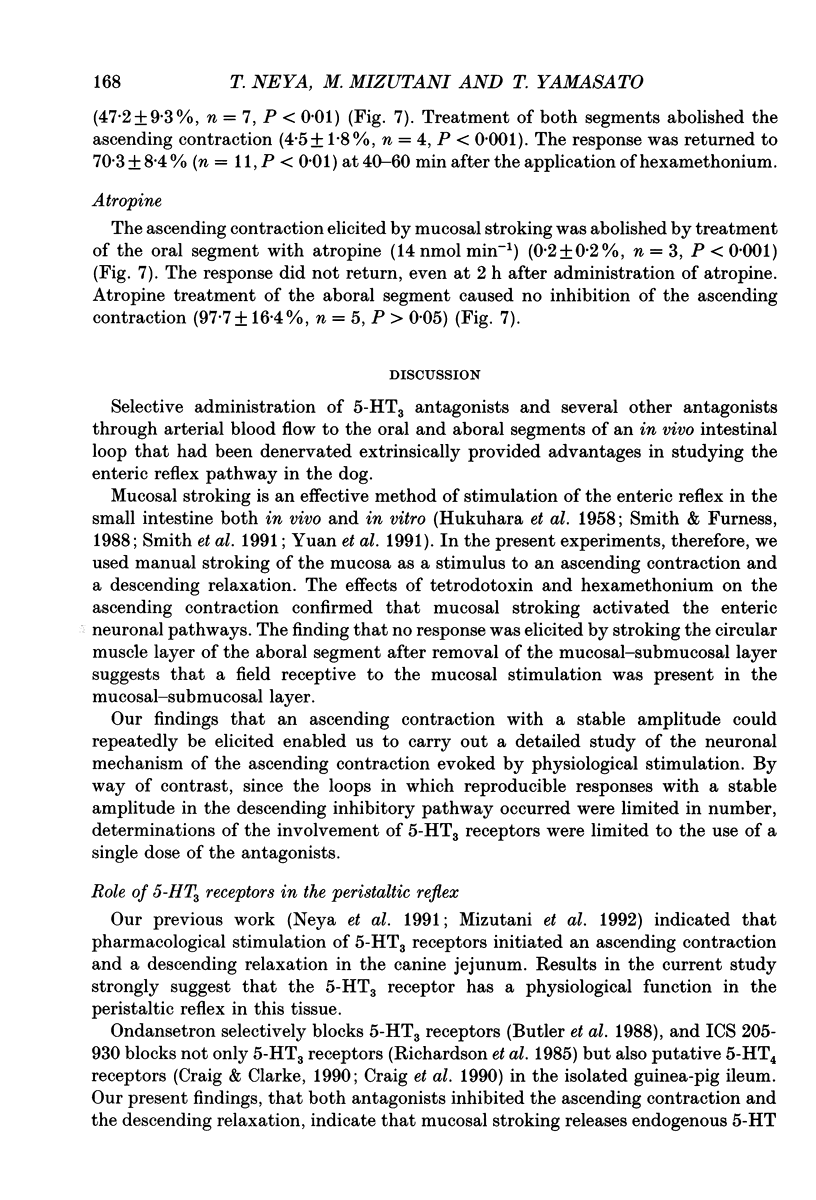
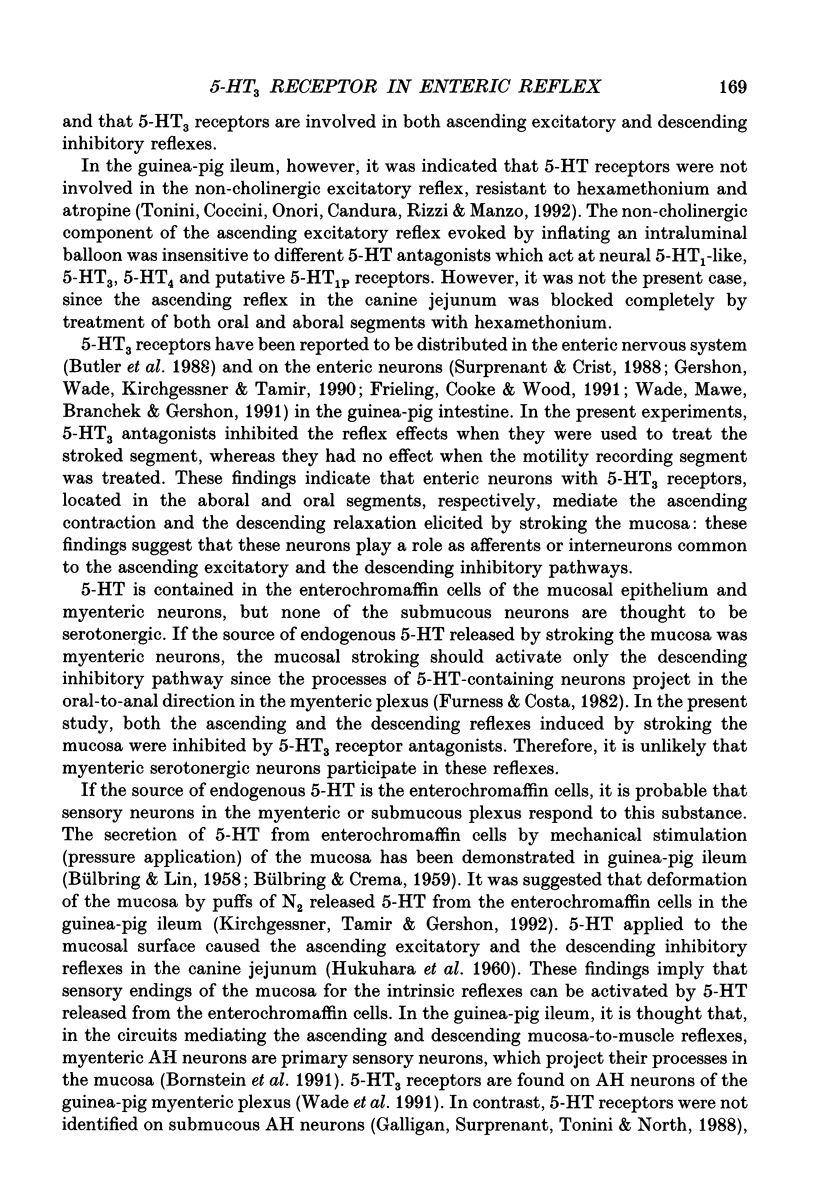
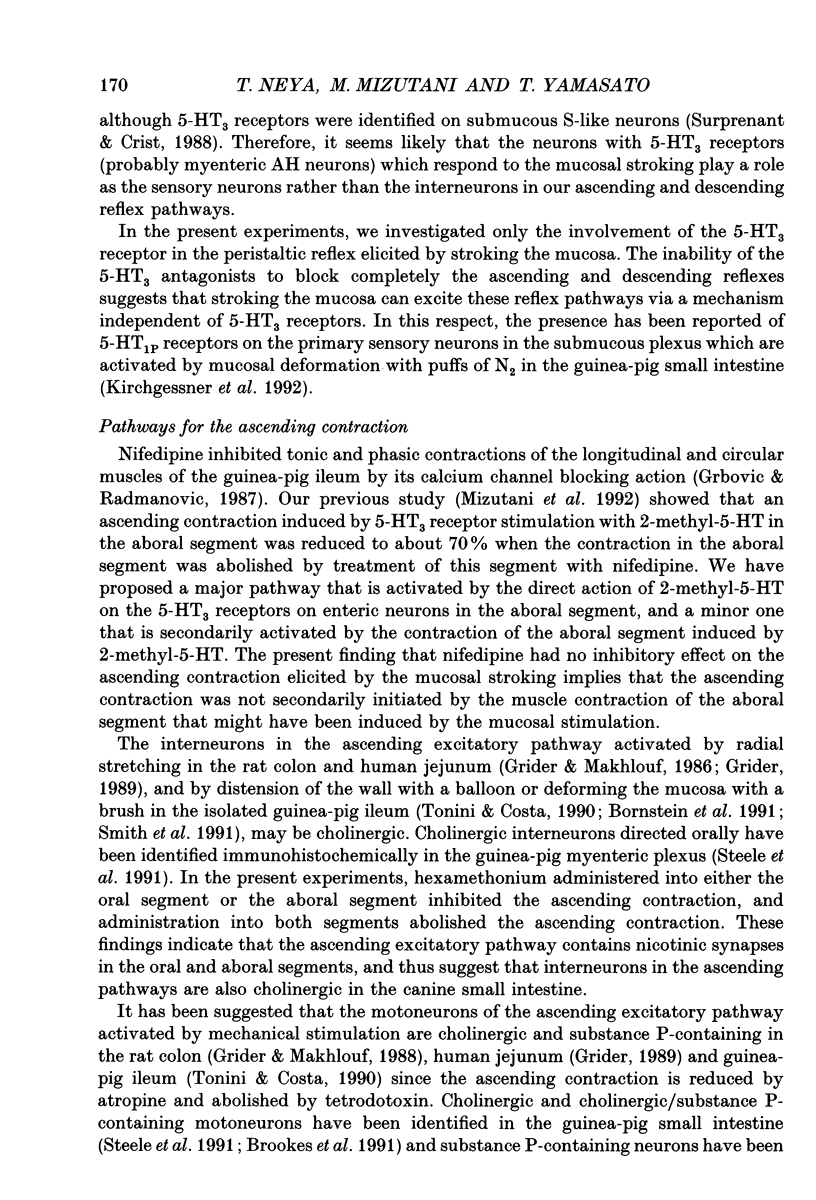
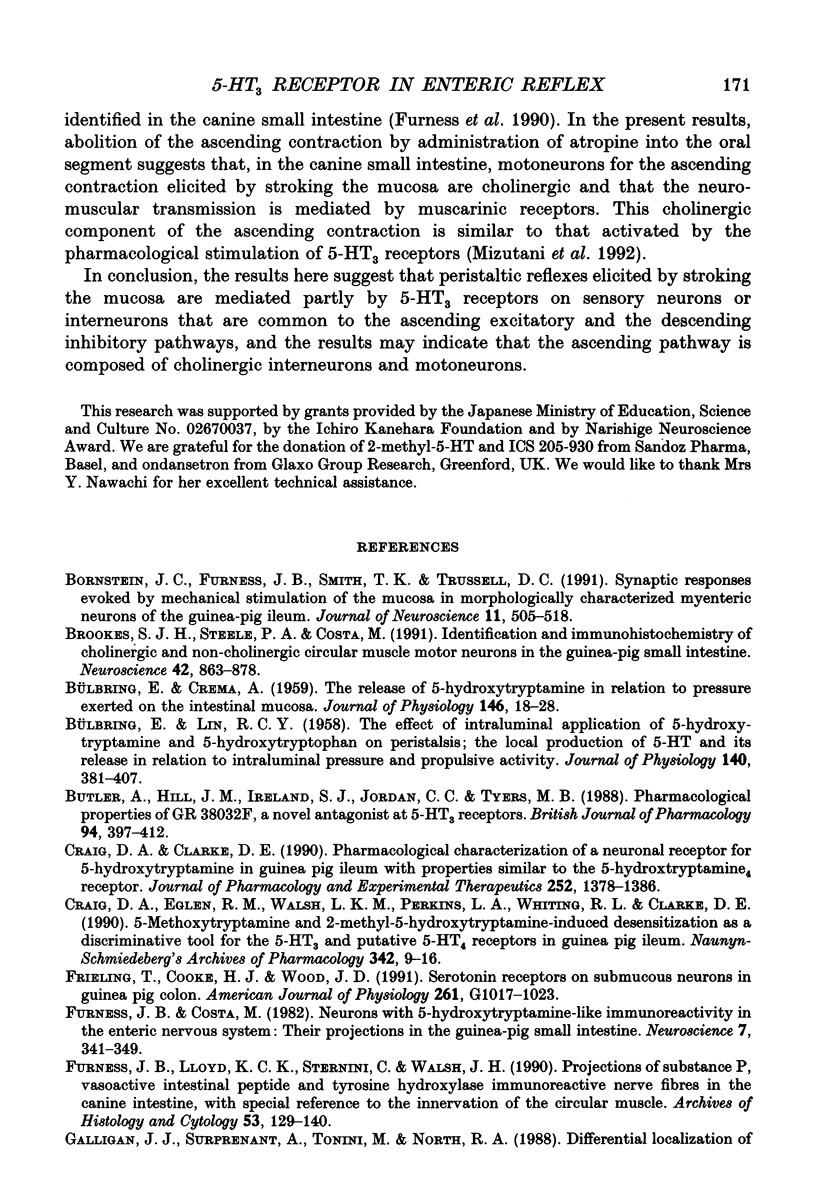
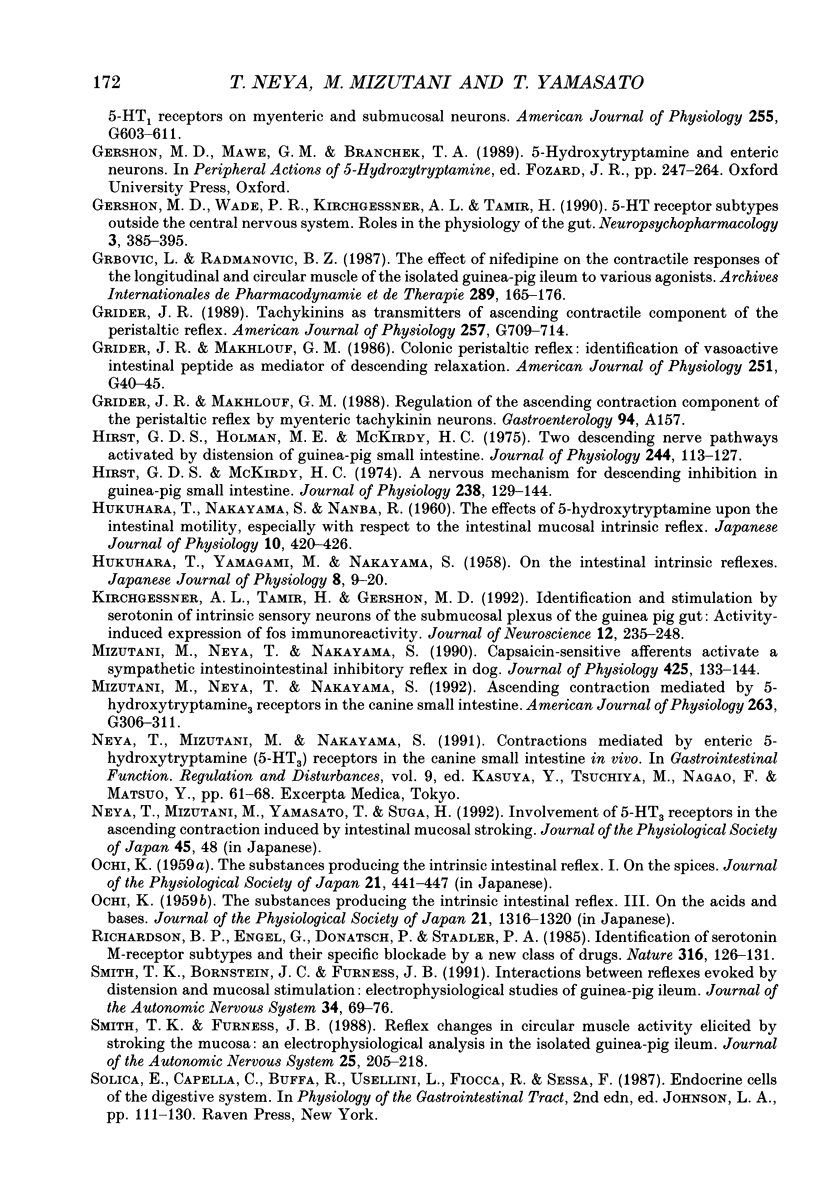
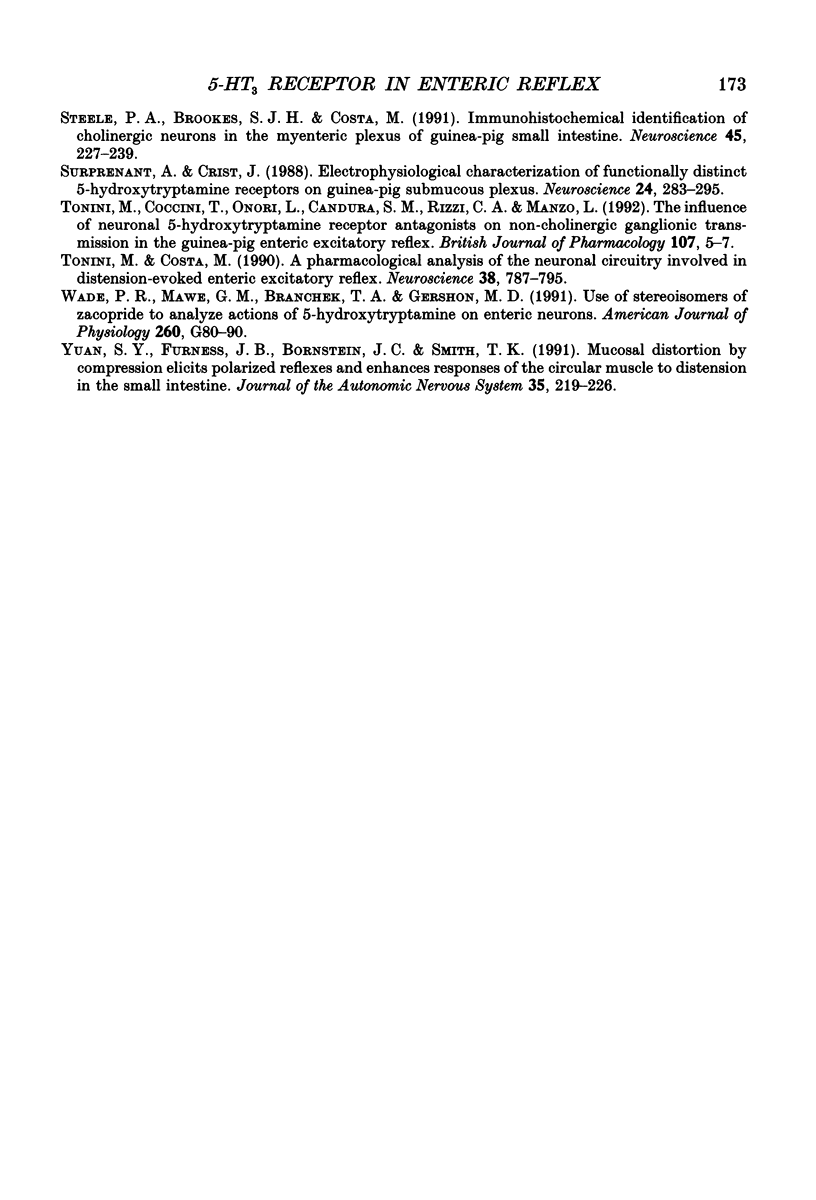
Images in this article
Selected References
These references are in PubMed. This may not be the complete list of references from this article.
- BULBRING E., CREMA A. The release of 5-hydroxytryptamine in relation to pressure exerted on the intestinal mucosa. J Physiol. 1959 Apr 23;146(1):18–28. doi: 10.1113/jphysiol.1959.sp006175. [DOI] [PMC free article] [PubMed] [Google Scholar]
- BULBRING E., LIN R. C. The effect of intraluminal application of 5-hydroxytryptamine and 5-hydroxytryptophan on peristalsis; the local production of 5-HT and its release in relation to intraluminal pressure and propulsive activity. J Physiol. 1958 Mar 11;140(3):381–407. [PMC free article] [PubMed] [Google Scholar]
- Bornstein J. C., Furness J. B., Smith T. K., Trussell D. C. Synaptic responses evoked by mechanical stimulation of the mucosa in morphologically characterized myenteric neurons of the guinea-pig ileum. J Neurosci. 1991 Feb;11(2):505–518. doi: 10.1523/JNEUROSCI.11-02-00505.1991. [DOI] [PMC free article] [PubMed] [Google Scholar]
- Brookes S. J., Steele P. A., Costa M. Identification and immunohistochemistry of cholinergic and non-cholinergic circular muscle motor neurons in the guinea-pig small intestine. Neuroscience. 1991;42(3):863–878. doi: 10.1016/0306-4522(91)90050-x. [DOI] [PubMed] [Google Scholar]
- Butler A., Hill J. M., Ireland S. J., Jordan C. C., Tyers M. B. Pharmacological properties of GR38032F, a novel antagonist at 5-HT3 receptors. Br J Pharmacol. 1988 Jun;94(2):397–412. doi: 10.1111/j.1476-5381.1988.tb11542.x. [DOI] [PMC free article] [PubMed] [Google Scholar]
- Craig D. A., Clarke D. E. Pharmacological characterization of a neuronal receptor for 5-hydroxytryptamine in guinea pig ileum with properties similar to the 5-hydroxytryptamine receptor. J Pharmacol Exp Ther. 1990 Mar;252(3):1378–1386. [PubMed] [Google Scholar]
- Craig D. A., Eglen R. M., Walsh L. K., Perkins L. A., Whiting R. L., Clarke D. E. 5-Methoxytryptamine and 2-methyl-5-hydroxytryptamine-induced desensitization as a discriminative tool for the 5-HT3 and putative 5-HT4 receptors in guinea pig ileum. Naunyn Schmiedebergs Arch Pharmacol. 1990 Jul;342(1):9–16. doi: 10.1007/BF00178965. [DOI] [PubMed] [Google Scholar]
- Frieling T., Cooke H. J., Wood J. D. Serotonin receptors on submucous neurons in guinea pig colon. Am J Physiol. 1991 Dec;261(6 Pt 1):G1017–G1023. doi: 10.1152/ajpgi.1991.261.6.G1017. [DOI] [PubMed] [Google Scholar]
- Furness J. B., Costa M. Neurons with 5-hydroxytryptamine-like immunoreactivity in the enteric nervous system: their projections in the guinea-pig small intestine. Neuroscience. 1982 Feb;7(2):341–349. doi: 10.1016/0306-4522(82)90271-8. [DOI] [PubMed] [Google Scholar]
- Furness J. B., Lloyd K. C., Sternini C., Walsh J. H. Projections of substance P, vasoactive intestinal peptide and tyrosine hydroxylase immunoreactive nerve fibres in the canine intestine, with special reference to the innervation of the circular muscle. Arch Histol Cytol. 1990 May;53(2):129–140. doi: 10.1679/aohc.53.129. [DOI] [PubMed] [Google Scholar]
- Gershon M. D., Wade P. R., Kirchgessner A. L., Tamir H. 5-HT receptor subtypes outside the central nervous system. Roles in the physiology of the gut. Neuropsychopharmacology. 1990 Oct-Dec;3(5-6):385–395. [PubMed] [Google Scholar]
- Grbović L., Radmanović B. Z. The effect of nifedipine on the contractile responses of the longitudinal and circular muscle of the isolated guinea-pig ileum to various agonists. Arch Int Pharmacodyn Ther. 1987 Oct;289(2):165–176. [PubMed] [Google Scholar]
- Grider J. R. Tachykinins as transmitters of ascending contractile component of the peristaltic reflex. Am J Physiol. 1989 Nov;257(5 Pt 1):G709–G714. doi: 10.1152/ajpgi.1989.257.5.G709. [DOI] [PubMed] [Google Scholar]
- HUKUHARA T., YAMAGAMI M., NAKAYAMA S. On the intestinal intrinsic reflexes. Jpn J Physiol. 1958 Mar 30;8(1):9–20. doi: 10.2170/jjphysiol.8.9. [DOI] [PubMed] [Google Scholar]
- Hirst G. D., Holman M. E., McKirdy H. C. Two descending nerve pathways activated by distension of guinea-pig small intestine. J Physiol. 1975 Jan;244(1):113–127. doi: 10.1113/jphysiol.1975.sp010786. [DOI] [PMC free article] [PubMed] [Google Scholar]
- Hirst G. D., McKirdy H. C. A nervous mechanism for descending inhibition in guinea-pig small intestine. J Physiol. 1974 Apr;238(1):129–143. doi: 10.1113/jphysiol.1974.sp010514. [DOI] [PMC free article] [PubMed] [Google Scholar]
- Kirchgessner A. L., Tamir H., Gershon M. D. Identification and stimulation by serotonin of intrinsic sensory neurons of the submucosal plexus of the guinea pig gut: activity-induced expression of Fos immunoreactivity. J Neurosci. 1992 Jan;12(1):235–248. doi: 10.1523/JNEUROSCI.12-01-00235.1992. [DOI] [PMC free article] [PubMed] [Google Scholar]
- Mizutani M., Neya T., Nakayama S. Ascending contraction mediated by 5-hydroxytryptamine3 receptors in canine small intestine. Am J Physiol. 1992 Sep;263(3 Pt 1):G306–G311. doi: 10.1152/ajpgi.1992.263.3.G306. [DOI] [PubMed] [Google Scholar]
- Mizutani M., Neya T., Nakayama S. Capsaicin-sensitive afferents activate a sympathetic intestinointestinal inhibitory reflex in dogs. J Physiol. 1990 Jun;425:133–144. doi: 10.1113/jphysiol.1990.sp018096. [DOI] [PMC free article] [PubMed] [Google Scholar]
- Richardson B. P., Engel G., Donatsch P., Stadler P. A. Identification of serotonin M-receptor subtypes and their specific blockade by a new class of drugs. Nature. 1985 Jul 11;316(6024):126–131. doi: 10.1038/316126a0. [DOI] [PubMed] [Google Scholar]
- Smith T. K., Bornstein J. C., Furness J. B. Interactions between reflexes evoked by distension and mucosal stimulation: electrophysiological studies of guinea-pig ileum. J Auton Nerv Syst. 1991 Jun 1;34(1):69–75. doi: 10.1016/0165-1838(91)90009-r. [DOI] [PubMed] [Google Scholar]
- Smith T. K., Furness J. B. Reflex changes in circular muscle activity elicited by stroking the mucosa: an electrophysiological analysis in the isolated guinea-pig ileum. J Auton Nerv Syst. 1988 Dec;25(2-3):205–218. doi: 10.1016/0165-1838(88)90025-2. [DOI] [PubMed] [Google Scholar]
- Steele P. A., Brookes S. J., Costa M. Immunohistochemical identification of cholinergic neurons in the myenteric plexus of guinea-pig small intestine. Neuroscience. 1991;45(1):227–239. doi: 10.1016/0306-4522(91)90119-9. [DOI] [PubMed] [Google Scholar]
- Surprenant A., Crist J. Electrophysiological characterization of functionally distinct 5-hydroxytryptamine receptors on guinea-pig submucous plexus. Neuroscience. 1988 Jan;24(1):283–295. doi: 10.1016/0306-4522(88)90331-4. [DOI] [PubMed] [Google Scholar]
- Tonini M., Costa M. A pharmacological analysis of the neuronal circuitry involved in distension-evoked enteric excitatory reflex. Neuroscience. 1990;38(3):787–795. doi: 10.1016/0306-4522(90)90071-b. [DOI] [PubMed] [Google Scholar]
- Yuan S. Y., Furness J. B., Bornstein J. C., Smith T. K. Mucosal distortion by compression elicits polarized reflexes and enhances responses of the circular muscle to distension in the small intestine. J Auton Nerv Syst. 1991 Sep;35(3):219–226. doi: 10.1016/0165-1838(91)90100-h. [DOI] [PubMed] [Google Scholar]




